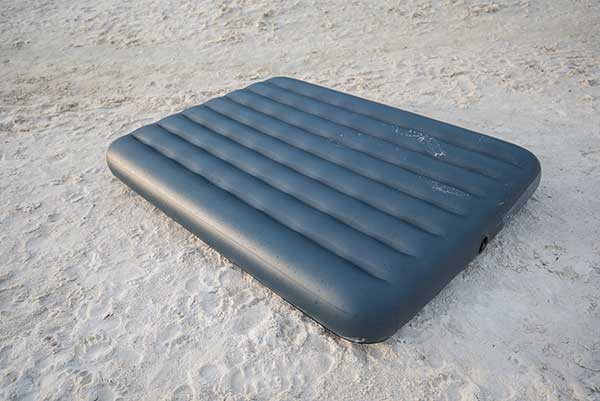Anything that is considered to be a pressurized container made out of polymers, including air mattresses, will gradually lose air over time.
This can include things such as balloons and car tires too. Even in cases where your air mattress may seem 100% air-tight, gas molecules can still slowly seep out through the material itself.
It will happen slowly over time, and there is no way to stop it from happening. However, there are ways to slow it down and stop from being grand amounts of air loss.
Certain factors can increase the rate of deflation and make it have a more dramatic effect. Whether you are using your air mattress indoors, inside a home, or when you are out camping, there are some ways you can avoid the worst.
Of course, you also want to be extra mindful of sharp objects that could cause extreme air-loss, such as punctures.

Table of Contents
How to prevent deflation?
Air mattresses deflating overnight is sadly a rather common problem in current times. Many people will settle for having an air pump on hand, or just accept waking up on what is about as sturdy as a waterbed.
However, this can get annoying if you regularly use air mattresses and you may want to find a way to keep the mattress as sturdy as possible overnight, losing as little air as possible. So, how can you prevent this sort of problem?
Check your surroundings
One of the simplest ways to stop your air mattress from losing air drastically overnight is to check the area you are sleeping in.
Whether you are in a home or out camping in a tent or otherwise, you should keep an eye out for anything that has the potential to puncture your mattress.
The area should also be large enough to accommodate the size of your mattress, if it is too small, anticipate the air being pushed out faster.
A fully inflated mattress could even be punctured by something as simple as the edge of a table, or a flat twig, or a small pebble. The material that an air mattress is made of is thin and so you need to be mindful of any possible, even minutely small, sharp objects.
It is very possible to have a puncture that is so small you don’t notice it for ages as it only slowly leaks air and doesn’t make the ‘hissing’ noise of expelled air that you would expect.
Let your mattress stretch
An air mattress will naturally expand slightly after the first use or two. This is simply the material coming to terms with the fact it is going to be used repeatedly.
During the first tries, it will naturally stretch. Don’t worry this is normal. After a few nights, it will stretch to its natural furthest which should result in more comfort in your sleep.
If you want to avoid significant deflation then you should inflate the bed for a few days without using it. It also helps to do this, to air it out, ridding it of unpleasant factory smells.
What is the capacity?
Like most things, any airbed will come with a maximum weight limit. It will usually be found in the instructions.
Do not overload the mattress as it will result in the formations of bubbles and even lumps across the mattress as well as a significant air loss.
Look out for punctures
If you do find any punctures, patch them up. Many people will use duct tape or another strong sealant tape to do this.
This is a good way to control and minimalize any extensive air loss from your mattress.
Anti-deflation tutorial
We have already looked at a few factors that can cause and prevent air-loss.
Now let’s have a look at some tips you should do before setting up your air mattress to get the best quality sleep out of it.
Folding your mattress
When you are not using your mattress you will have to fold it up to put it away and store it. It is very good for space-saving, however, don’t just cram it up haphazardly.
Be cautious and careful, folding along the seams and doing so slowly. This way you can minimalize any tears that may occur.
Temperature-awareness
Temperature is easy to monitor and manipulate if you are in your own home, however, if you are out camping this can be much more difficult.
Air expands in heat and shrinks when cold. If the temperature fluctuates you may end up seeing tears appear and damage to the outer layer of the mattress.
Most mattresses are also designed to operate at room temperatures. So if possible try to maintain this temperature.
If you use the mattress for camping getting a small heater or keeping your tent warm/closed can help prevent and drastic temperature changes from affecting it.
Laying on your mattress
Side sleepers, we are sorry. Air mattresses are best for evenly distributed weight, meaning that sleeping flat on your back is the best way to sleep on them.
However, you should also change positions each time you sleep on it, meaning that you sleep in the center one time, then on the left, then the right, so the mattress is evenly impacted by your weight.
Avoid daily-use
These are not intended for daily use. They are mainly for camping and outdoor use. You should also not sit or lay on it for too long as it will accelerate the wear and tear.Obviously, you can sleep on it for a night, but don’t go using it as your permanent bed or chill-out on it all day.
Being mindful of the nozzle
Most of the time, air will seep out of the nozzle rather than tears. This is often because the nozzle is not tightly sealed and the air can seep out.
All you need to do is make sure that you seal it tightly after inflating.
Deflation
Finally, deflate the mattress when you are not using it, if the air pressure maintains on the fabric for too long while not being used it can weaken the fabric.
Deflating the mattress stops this pressure from occurring and will extend the lifespan of your mattress greatly.
- Are Merrell Shoes Good? – An Unbiased Review of Merrell Footwear - December 9, 2023
- Where Are Merrell Shoes Made? - December 9, 2023
- Camping in 40-degree Weather: Tips and Tricks - September 25, 2023

![Why is My Air Mattress Deflating but No Holes? [5 Possible Reasons] Why is My Air Mattress Deflating but No Holes? [5 Possible Reasons]](https://grandcircletrails.com/wp-content/uploads/2021/09/Why-is-My-Air-Mattress-Deflating-but-No-Holes-1-150x150.jpg)


![What to Put Under Air Mattress When Camping? [Detailed Guide] What to Put Under Air Mattress When Camping? [Detailed Guide]](https://grandcircletrails.com/wp-content/uploads/2022/06/What-to-Put-Under-Air-Mattress-When-Camping-150x150.jpg)
![How Long Do Thermal Bags Keep Food Cold? [Detailed Answer] How Long Do Thermal Bags Keep Food Cold? [Detailed Answer]](https://grandcircletrails.com/wp-content/uploads/2022/05/How-Long-Do-Thermal-Bags-Keep-Food-Cold-150x150.png)
